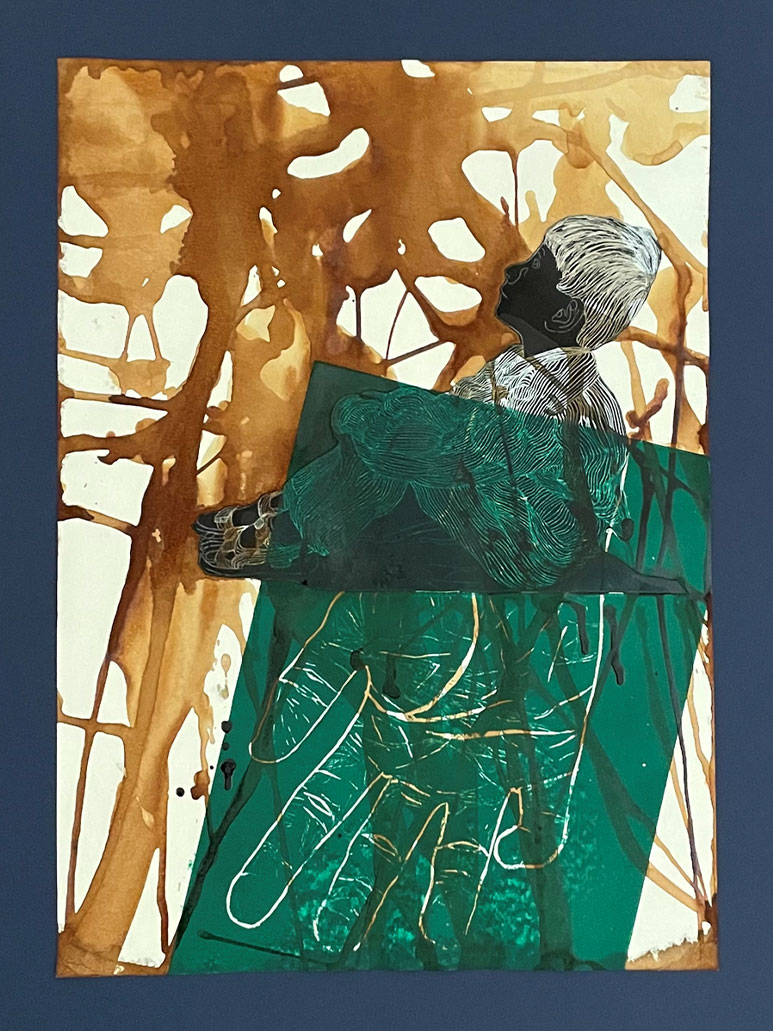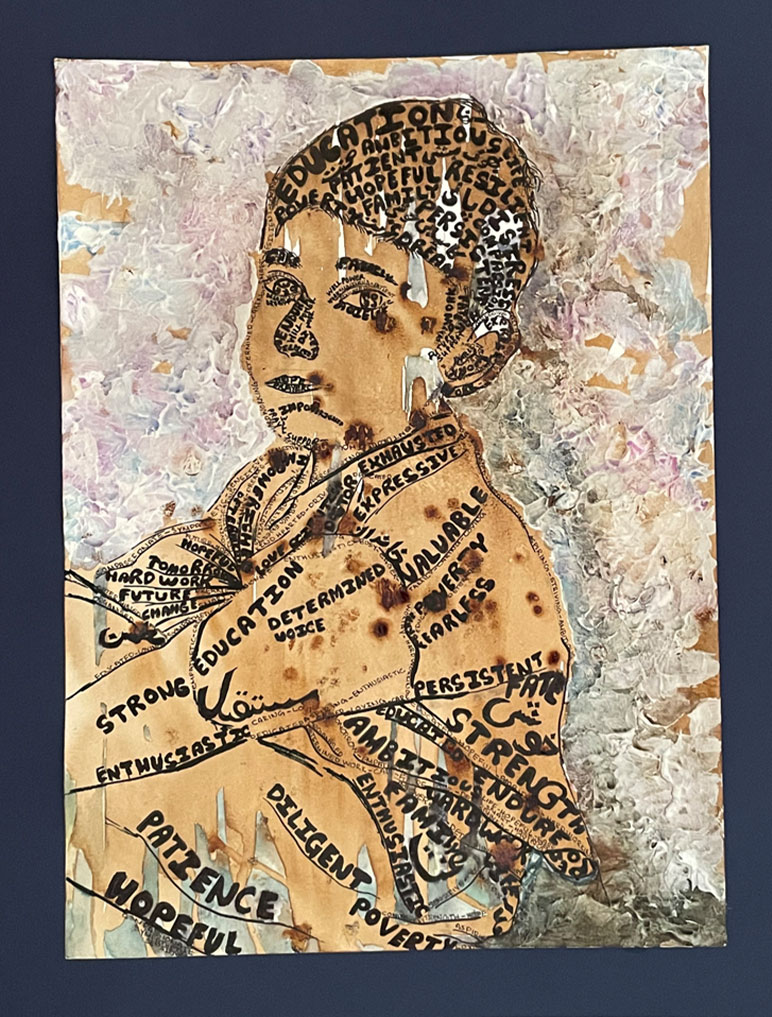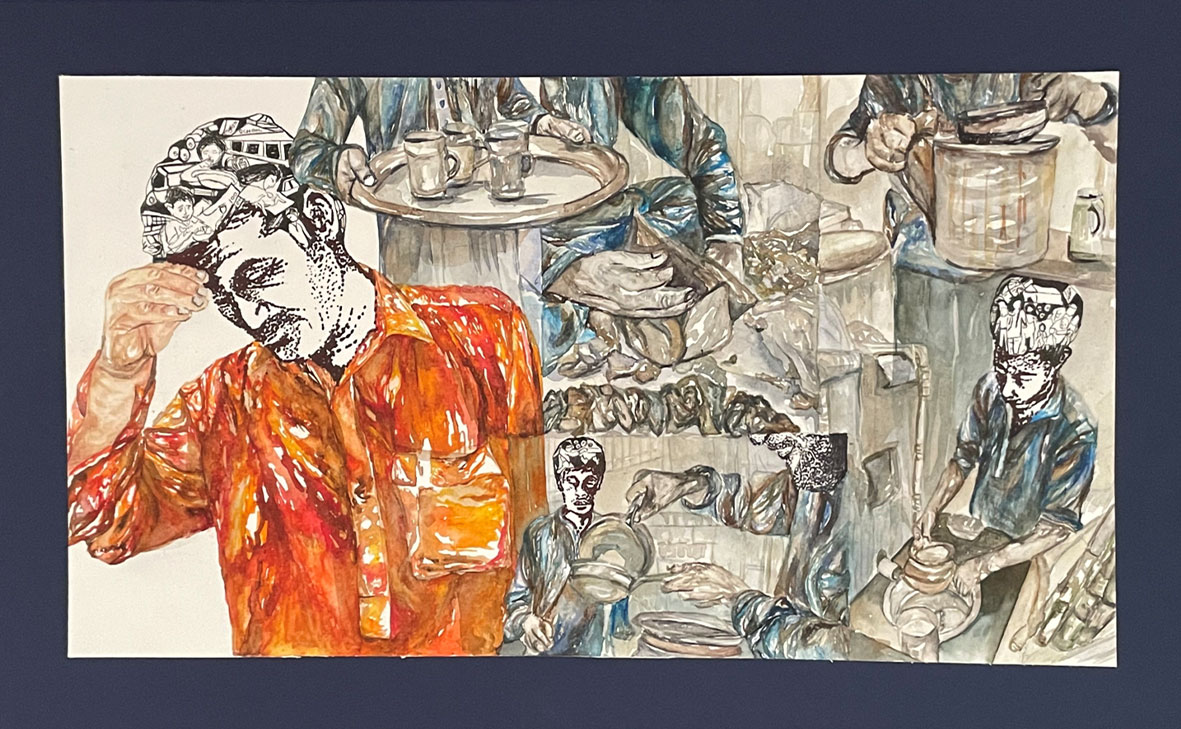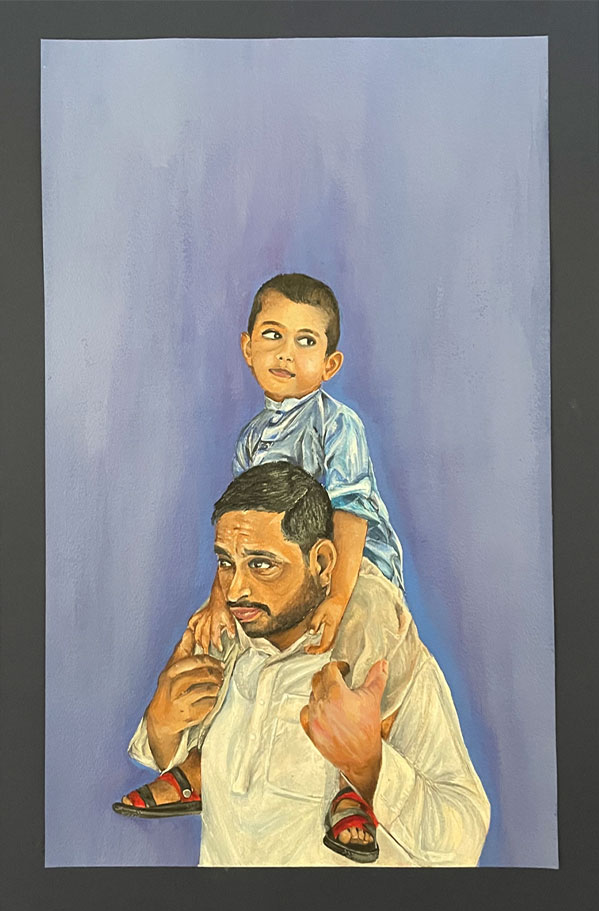Lines of Fate
I often think about how fate plays a role in our lives. Looking at the lines of fate in my palms, I wonder whether they determine my future. Palmists and palmistry is part Pakistani culture, their brightly decorated stalls usually seen in low-income neighborhoods. People are born with these lines of fate; how do they impact their lives? Do their lives impact these lines as well? My experience in teaching students from under-privileged neighborhoods made this question even more potent for me. In these art pieces, I explore the idea of how a child is born with a fate; and how sometimes, choices and efforts made by them and their parents improves their lives.
‘Lines in my palm’
Pen on paper, coffee drip, lino printmaking, 16"x20"
In this art piece, I explore the concept of fate; how we are all born with these lines of fate in
our palms.
Inspired by these lines of fate, I represented the child using artist Adeel Zafar’s painting
technique in which he
uses very fine lines. The hand that is under the child shows how our lines of fate ground us and it
is the one thing
that everyone is born with. I experimented with Lino to represent the intriacte lines in the palms;
I chose the
colour green for the Lino printing because it is the colour of hope and optimism. The background,
made with
coffee-staining, reflects the thought that despite the lines
of our fate with which we are born, we cannot predict
how life will unfold.


‘Conflict of emotion’
Watercolour on paper, coffee drip, calligram in marker, 16"x20"
Lines of fate lead to emotions we experience. Here I use words to explore the feelings of an
individual child based
on his experiences. Symbolizing emotions linked to fate, negative and positive words in black paint
have been
juxtaposed to represent the combination of struggle and hope that keeps him going; these conflicting
emotions are
also reflected in the use of mixed mediums. Gesso has been used to show a combination of intense
hope and optimism.
The way his life will unfold is unpredictable; I represent this using a coffee-staining technique
where I have
limited control over the medium; its organic, just how his life flows.
‘Power in my hands’
Watercolour & marker on paper, 12"x19"
Though each child is born with their own lines of fate, parents usually take up the burden of
providing for them. In
this painting I have shown a father who is trying to provide the best life possible to his child. He
is seen serving
chai (tea), making
Gajras (flower necklaces); all intense physical activity involving the use of hands.
Even though
we are born with lines of fate in our hands, our hands are capable of creating, nurturing and
holding life for us. I
used water colour medium, which is softer and free flowing, to represent the flow of life and how
fluid life can be.
I was inspired by artist Jitish Kallat painting style to represent the concerns and worries in the
father’s mind;
where the child is eating, going to school. I juxtaposed water colour with the use of black marker;
I have used it
in a defined non flexible way, representing the realization that when it comes to his child, the
father has little
room for mistakes.


‘I will make it through’
Mixed media, corrugated paper, phototransfer, chalk pastels, charcoal, acrylic
and watercolour, salt 15.5"x20"
In this art piece, I represent the life of children from under-privileged backgrounds. A combination
of rough and refined mediums used reflect their fragility through life’s ups and downs; these
children come from households which demand a lot from them; they have to study and earn. The hand
print is a constant reminder, as well as a consolation, that though their fate is written in their
hands, they can alter their destiny through their hard work, community support and hope. Through the
use of collage technique, I have portrayed the myriad of challenges they experience and the glue
used helps to portray their sense of togetherness through these challenges.
‘Changing destiny together’
Detailed acrylics on archive paper, 17"x25.5"
While a child is born with their fate written in their palms, both the parent and the child together
take responsibility for their destiny. In doing so, especially in an underprivileged family, they
become one unit. I chose a singular medium of acrylic for this painting, to portray the unified
spirit of a father and son. The loving way the father carries his son on his shoulders shows they
are unified, not only by circumstances, but also by fate. The strong colour hues used shows that
their unity is their strength.

Gajras: Made by my hand for your hand
In the following pieces, I explored the strenuous work which goes into the making of the Gajras (flower bracelets). This is a traditional Pakistani craft that reflects hard work done by the hand requiring dexterity of the hand, rigorous craftsmanship and precision. Locally grown roses are used, in combination with white flowers such as Motia (Arabian Jasmine) or Tube roses. Gajras are commonly worn on traditional festivals and weddings.
‘Worn with love’
Mix media on paper, colour pencils, pen, artificial rose petals, 14"x15"
In this piece I explore the cultural significance of Gajras in Pakistani culture and tradition. I
used mixed media, colour pencils, pen and artificial rose petals to create a “thaal” (platter) which
is presented at the mehndi (henna) event at weddings. The silver tray, painted using acrylic
paints,
is a staple element in weddings. The impact of the traditional mehndi designs on the hands is
further enhanced by the red roses of the Gajras. These mediums come together to reflect the richness
that Gajras add to the festivities.


‘From my hands to yours’
Newspaper, chalks, acrylics, 7.5"x6"
In this piece, I focus on how the Gajra, once it has been made, is wrapped in a newspaper when
handed to the customer. It represents the limited budget and resources which the craftsmen works
with, yet is still able to showcase the beauty of the Gajra. It represents his eagerness and
devotion to his craft. The use of the chalks and acrylic paints for the Gajra elevates its
attraction.
‘Beauty of Red and White’
Acrylics with knife on cloth painted with white glue, 10"x12"
In this piece, I focus on the Gajras hung for display at the flower shop. I used Artist Sumaya
Jillani’s technique: I took a brightly coloured cloth and applied three coats of glue and let it
dry; then I painted on top of it using acrylic paints, highlighting the blending of shades giving an
overall realistic look.


‘Made with hands’
Poster paints & charcoal on yellow paper, 12"x9.5"
In this piece, I explore the hand work that goes into making a Gajra; the way the craftsmen
intricately laces each petal together to create this piece of jewelry. I used the medium of poster
paints in contrast with charcoal to highlight the red and white colour of the petals. This craft is
their livelihood and a means of providing their children a brighter future; hence I used yellow
coloured paper radiating hope and positivity.